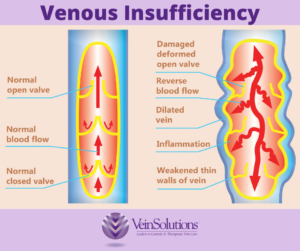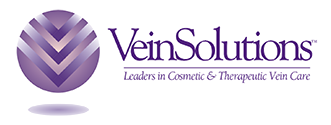February is American Heart Month, a time dedicated to raising awareness about heart health and…
What is Venous Insufficiency?
At VeinSolutions in Austin, we treat everything from thin and wispy spider veins to the more serious deep venous disorders, and everything in between. One condition that is central and common to so many vein disorders we see is venous insufficiency.
Venous insufficiency occurs when veins have a hard time returning blood flow from the limbs (typically legs) back towards the heart. This can lead to dangerous issues with poor circulation, elevated blood pressure, and even stroke if left untreated.
Women should be extra aware of symptoms associated with venous insufficiency — especially those who are over 50 years old and have had multiple pregnancies that may have put a great deal of stress on the body. Nearly 40% of all adults in the U.S. have chronic venous insufficiency or suffered from it at one time.
What are symptoms of venous insufficiency?
Common symptoms characteristic of venous insufficiency include:
- Swelling or heaviness in legs and ankles
- Aching, throbbing or cramping in the legs
- Weak and tired legs
- Thickening or discoloration of the skin on legs or ankles
- Leg ulcers, or sores, that do not heal
What causes venous insufficiency?
It is most often caused by blood clots or varicose veins. A blood clot occurs when the regular blood flow through a vein is obstructed and the built-up blood pools and forms a gelatinous clot or a sort of plug.
Improper blood flow from valves within the veins of the leg is commonly what causes varicose veins. This hinders blood flow back up through the rest of the body and gives varicose veins their thick, knotted structure under the skin.
Additional factors that may lead to venous insufficiency are obesity, pregnancy, smoking, leg injury or trauma, and a family history of venous disorders.
How is venous insufficiency treated?
The first forms of intervention that our team of board-certified vascular surgeons recommend are usually non-surgical. Losing weight, getting enough exercise, and wearing compression stockings to improve circulation can go a long way in healing venous insufficiency. If these methods are unsuccessful, a stronger course of action may be required such as anticoagulant medication (blood thinners) or surgery.
The surgical treatments that we offer at VeinSolutions are done in a convenient outpatient setting with minimal bandages, scarring and recovery times afterwards. They not only fix the damaging effects of the venous insufficiency, but you’ll feel less pain and like the appearance of your legs afterwards.
Patients are usually able to walk out of the office on their own and even return to work later that day with the following treatments:
- Sclerotherapy: a non-invasive procedure performed by injecting a chemical solution into damaged veins causing them to dissolve
- Endovenous Ablation: threading of a small catheter through affected veins that are then sealed off via radiofrequency energy/heat, or cyanoacrylate glue, such as VenaSeal
- Minimally Invasive Vein Surgery: surgically tying off or removing damaged veins through a tiny incision in the leg guided by a microscopic camera
Please visit us here to schedule an appointment with one of our board-certified specialists at VeinSolutions in Austin, or contact us at 512.452.VEIN (8346). For VeinSolutions in Georgetown, please contact us at 512-501-4287 to schedule an appointment.
Don’t forget to follow us on Facebook and Instagram.

(Source: Society for Vascular Surgery)



